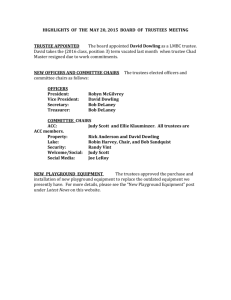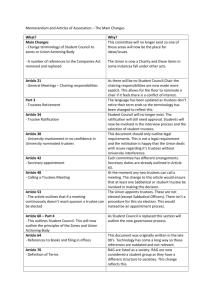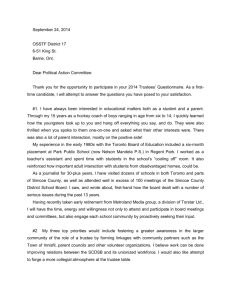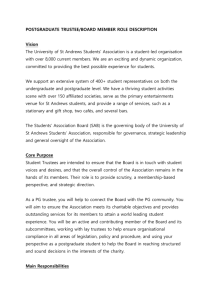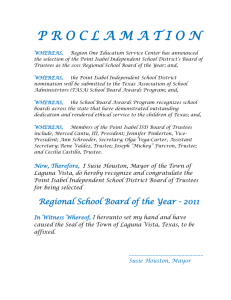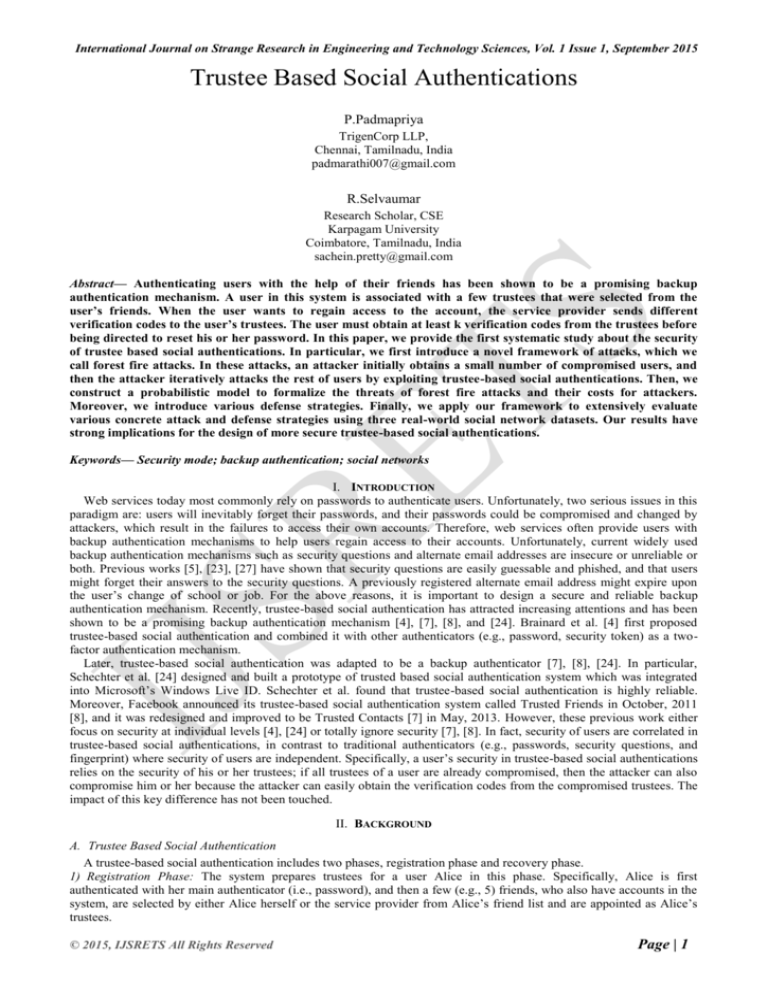
International Journal on Strange Research in Engineering and Technology Sciences, Vol. 1 Issue 1, September 2015
Trustee Based Social Authentications
P.Padmapriya
TrigenCorp LLP,
Chennai, Tamilnadu, India
padmarathi007@gmail.com
R.Selvaumar
Research Scholar, CSE
Karpagam University
Coimbatore, Tamilnadu, India
sachein.pretty@gmail.com
Abstract— Authenticating users with the help of their friends has been shown to be a promising backup
authentication mechanism. A user in this system is associated with a few trustees that were selected from the
user’s friends. When the user wants to regain access to the account, the service provider sends different
verification codes to the user’s trustees. The user must obtain at least k verification codes from the trustees before
being directed to reset his or her password. In this paper, we provide the first systematic study about the security
of trustee based social authentications. In particular, we first introduce a novel framework of attacks, which we
call forest fire attacks. In these attacks, an attacker initially obtains a small number of compromised users, and
then the attacker iteratively attacks the rest of users by exploiting trustee-based social authentications. Then, we
construct a probabilistic model to formalize the threats of forest fire attacks and their costs for attackers.
Moreover, we introduce various defense strategies. Finally, we apply our framework to extensively evaluate
various concrete attack and defense strategies using three real-world social network datasets. Our results have
strong implications for the design of more secure trustee-based social authentications.
Keywords— Security mode; backup authentication; social networks
I. INTRODUCTION
Web services today most commonly rely on passwords to authenticate users. Unfortunately, two serious issues in this
paradigm are: users will inevitably forget their passwords, and their passwords could be compromised and changed by
attackers, which result in the failures to access their own accounts. Therefore, web services often provide users with
backup authentication mechanisms to help users regain access to their accounts. Unfortunately, current widely used
backup authentication mechanisms such as security questions and alternate email addresses are insecure or unreliable or
both. Previous works [5], [23], [27] have shown that security questions are easily guessable and phished, and that users
might forget their answers to the security questions. A previously registered alternate email address might expire upon
the user’s change of school or job. For the above reasons, it is important to design a secure and reliable backup
authentication mechanism. Recently, trustee-based social authentication has attracted increasing attentions and has been
shown to be a promising backup authentication mechanism [4], [7], [8], and [24]. Brainard et al. [4] first proposed
trustee-based social authentication and combined it with other authenticators (e.g., password, security token) as a twofactor authentication mechanism.
Later, trustee-based social authentication was adapted to be a backup authenticator [7], [8], [24]. In particular,
Schechter et al. [24] designed and built a prototype of trusted based social authentication system which was integrated
into Microsoft’s Windows Live ID. Schechter et al. found that trustee-based social authentication is highly reliable.
Moreover, Facebook announced its trustee-based social authentication system called Trusted Friends in October, 2011
[8], and it was redesigned and improved to be Trusted Contacts [7] in May, 2013. However, these previous work either
focus on security at individual levels [4], [24] or totally ignore security [7], [8]. In fact, security of users are correlated in
trustee-based social authentications, in contrast to traditional authenticators (e.g., passwords, security questions, and
fingerprint) where security of users are independent. Specifically, a user’s security in trustee-based social authentications
relies on the security of his or her trustees; if all trustees of a user are already compromised, then the attacker can also
compromise him or her because the attacker can easily obtain the verification codes from the compromised trustees. The
impact of this key difference has not been touched.
II. BACKGROUND
A. Trustee Based Social Authentication
A trustee-based social authentication includes two phases, registration phase and recovery phase.
1) Registration Phase: The system prepares trustees for a user Alice in this phase. Specifically, Alice is first
authenticated with her main authenticator (i.e., password), and then a few (e.g., 5) friends, who also have accounts in the
system, are selected by either Alice herself or the service provider from Alice’s friend list and are appointed as Alice’s
trustees.
© 2015, IJSRETS All Rights Reserved
Page | 1
International Journal on Strange Research in Engineering and Technology Sciences, Vol. 1 Issue 1, September 2015
2) Recovery Phase: When Alice forgets her password or her password was compromised and changed by an attacker,
she recovers her account with the help of her trustees in this phase. Specifically, Alice first sends an account recovery
request with her username to the service provider which then shows Alice an URL. Alice is required to share this URL
with her trustees. Then, her trustees authenticate themselves into the system and retrieve verification codes using the
given URL. Alice then obtains the verification codes from her trustees via emailing them, calling them, or meeting them
in person. If Alice obtains a sufficient number (e.g., 3) of verification codes and presents them to the service provider,
then Alice is authenticated and is directed to reset her password. We call the number of verification codes required to be
authenticated the recovery threshold. Note that it is important for Alice to know who her trustees are in the Recovery
Phase. Schechter et al. [24] showed that users cannot remember their trustees via performing user studies. Thus, a usable
trustee-based social authentication system should remind Alice of her trustees. Next, we provide details about two
representative trusteebased social authentication systems which were implemented by Microsoft [24] and Facebook [7],
[8], respectively. In the Registration Phase of Trusted Contacts, a user selects three to five friends from his or her friend
list as trustees. The recovery threshold is also set to be three. Facebook does not remind a user of his or her trustees, but it
asks the user to type in the names of his or her trustees instead. However, once the user gets one trustee correctly,
Facebook will remind him or her of the remaining trustees.
B. Social Networks and Trustee Networks
We denote a social network as G = (V, E), where each node in V corresponds to a user in the service and an undirected
edge (u, v) represents that users u and v are friends. Moreover, in a trustee-based social authentication system, users and
their trustees form a directed network. We call this directed network a trustee network and denote it as GT = (VT , ET ),
where a node in VT is a user in the service and a directed edge (v, u) in ET means v is a trustee of u. One fundamental
challenge in trustee-based social authentication is how to construct the trustee network from a social network so that the
system is more secure.
III. THREAT MODEL
A. Background Knowledge
We assume that attackers know the trustee network in the target service. The reasonableness of this threat model is
supported by two evidences. First, attackers can obtain users’ usernames. A username is usually a string of letters, digits,
and special characters. Moreover, Bonneau et al. [3] showed that a majority (e.g., 96% in their studies) of websites
enable attackers to probe if a string is a legitimate username. Thus, strong attackers, who have enough resources (e.g., a
botnet) to perform username probings, can obtain all usernames in the target service. Second, Schechter et al. [24] found,
via performing user studies, that users cannot remember their own trustees. Therefore, a usable trustee-based social
authentication system must remind users of their trustees. Recall that an account recovery request only requires a
username. As a result, an attacker could send account recovery requests with the collected usernames to the service
provider which reminds the attacker of the trustees of each user.
Next, we take Facebook as an example to show how an attacker obtains the trustee network. First, Facebook provides
an interface1 to test if a user (represented by a username, real name, or email address) is in Facebook. Thus, the attacker
can perform username probings to collect Facebook users. Second, the attacker sends account recovery requests to
Facebook using the collected names. Recall that Facebook shows all trustees to a user once the user correctly types in
one trustee. Moreover, Bilge et al. [4] showed that an attacker can obtain friend lists of around 90% of Facebook users.
Thus, the attacker can repeatedly guess the trustees of a user until success. We note that Facebook only allows a user to
try around 10 times for typing in the trustees within a short period of time. However, such rate limit cannot prevent a
strong attacker from obtaining the trustee network eventually, though it can increase the attacker’s cost.
B. Forest Fire Attacks
1) Ignition Phase: In this phase, an attacker obtains a small number of compromised users which we call seed users.
They could be obtained from phishing attacks, statistical guessing, and password database leaks, or they could be a
coalition of users who collude each other. Indeed, a large number of social network accounts were reported to be
compromised,2 showing the feasibility of obtaining compromised seed users.
2) Propagation Phase: Given the seed users, the attacker iteratively attacks other users. In each attack iteration, the
attacker performs one attack trial to each of the uncompromised users according to some attack ordering of them. In an
attack trial to a user u, the attacker sends an account recovery request with u’s username to the service provider, which
issues different verification codes to u’s trustees. The goal of the attacker is to obtain verification codes from at least k
trustees. If at least k trustees of u are already compromised, the attacker can easily compromise u; otherwise, the attacker
can impersonate u and send a spoofing message to each uncompromised trustee of u to request the verification code.
Schechter et al. [24] found that such spoofing attacks can successfully retrieve a verification code with an average
probability around 0.05. Although the spoofing attacks can help attackers compromise more users, we want to stress that
they are optional.
3) Compromised Users could be Recovered: Users could recover their compromised accounts to be uncompromised
after they or the service provider detect suspicious activities of the accounts. For instance, a trustee of u receiving a
© 2015, IJSRETS All Rights Reserved
Page | 2
International Journal on Strange Research in Engineering and Technology Sciences, Vol. 1 Issue 1, September 2015
spoofing message might report to u, who then changes his or her password; the phenomenon that a trustee requests lots of
verification codes for different users within a short period of time is a possible indicator of forest fire attacks, and the
service provider could then notify the users, whose trustees have requested verification codes, to change passwords.
U3
U1
U4
U3
U1
U2
U5
U4
U3
U1
U2
U5
U4
U2
U5
Fig. 1 Illustration of forest fire attacks
IV. SECURITY MODEL
In this section, we introduce our security model to formalize the threats of forest fire attacks and their costs for
attackers. 1) Ignition Phase: If u is a seed user, then u’s initial compromise probability is 1, otherwise we model u’s
initial compromise probability as 0. 2) Propagation Phase: The key component is to update the aggregate compromise
probability of u when the aggregate compromise probabilities of u’s trustees are given.
C. Obtaining One Verification Code
We denote by A the event that the attacker obtains a verification code from a trustee v of u and the probability that A
happens in the tth attack iteration. Moreover, we denote the event that v is already compromised when the attacker
attacks u in the tth attack iteration as B. When B does not happen, the attacker can impersonate u and send a spoofing
message to v to request a verification code. We call the probability that such spoofing attacks succeed spoofing
probability. Spoofing probability might be different for different trustees. A trustee might behave differently to spoofing
messages impersonating different users because he or she might have different levels of trusts with the users that are
impersonated. Moreover, spoofing probability might be different in different attack iterations because trustees might
gradually become aware of the spoofing attacks.
D. Computing Compromise Probabilities
Recall that u is compromised if the attacker can obtain verification codes from at least k trustees of u. Thus, given the
natural assumption that u’s trustees are independent, the compromise probability of u in the tth attack iteration is
calculated.
E. Aggregating Compromise Probabilities
Assuming that whether u is compromised in one attack iteration is independent with whether u is compromised in
another attack iteration, we can iteratively compute the aggregate compromise probability.
V. ATTACK STRATEGIES
The attacker could design the seed users selection strategy and the attack ordering construction strategy to maximize
the expected number of compromised users. First, we show that finding the optimal set of seed users and the optimal
ordering construction strategy is NP-Complete. Then, we explore various scenarios where seed users have different
properties and introduce two ordering construction strategies.
A. Strategies for Selecting Seed Users
A seed users selection strategy S is essentially to assign a score which represents some metric of importance to each
user and to select ns users with the highest scores as seed users. This is closely related to the node centrality problem [18]
in the network science community. In the following, we modify a few node centrality heuristics as seed users selection
strategies. These strategies work on a trustee network, and we name them with a prefix ‘S-’ to indicate they are used to
select seed users.
© 2015, IJSRETS All Rights Reserved
Page | 3
International Journal on Strange Research in Engineering and Technology Sciences, Vol. 1 Issue 1, September 2015
1) S-Random
As a baseline, this strategy assigns a random score ranging from 0 to 1 to each user in the trustee network.
2) S-Degree
Intuitively, if a user u is selected as a trustee by more users, then compromising u will increase the compromise
probabilities of more users and thus the attacker has an opportunity to compromise more users. Therefore, S-Degree
treats the number of users that select u as a trustee (i.e., outdegree of u in the trustee network) as u’s score.
3) S-BadRank
S-BadRank, adapted from BadRank [2], performs a random walk on the trustee network. Specifically, S-BadRank
starts a random walk from u that is picked uniformly at random. The random walk will converge to a stationary
probability distribution over all users in the trustee network. The stationary probability of u is roughly the frequency with
which the random walk visits u and is used as u’s score. Intuitively, S-BadRank tends to assign a high score to a user that
is selected by many users as a trustee because he or she has a large chance to be visited by the random walk.
4) S-Closeness
The attacker could also select users that are close to all other users in the trustee network as seed users because
compromising them could help the attacker compromise other users more quickly. This intuition is formally captured by
the closeness metric [22]. Specifically, we define the distance between v and u as the length of the shortest directed path
whose tail is v and whose head is u. Then the closeness of u is defined as the inverse of the sum of its distances to all
other users, and it is treated as u’s score. In our experiments, we adopt the approximate algorithm developed by Okamoto
et al. [19] to find the top-ns users with the highest closeness scores since it is scalable to large networks.
VI. DEFENSE STRATEGIES
A. Hiding Trustee Networks
Preventing attackers from obtaining a trustee network is an essential step towards the defense of forest fire attacks. In
the currently deployed social authentication systems, attackers can obtain a trustee network because users need to know
their trustees to retrieve verification codes from them in the Recovery Phase. An alternative implementation of the
Recovery Phase is that the service provider directly sends verification codes to the trustees of the user when receiving an
account recovery request, and the trustees are required to actively share the verification codes to the user. This
implementation does not require users to know their trustees, and thus it is hard for attackers to obtain the trustee network.
However, this implementation is unreliable and could annoy users and their trustees. Specifically, u’s trustees might
already forget they are trustees of u, and thus they might simply treat those verification codes as spams and not share
them with u, which results in low reliability. Moreover, users do forget who their trustees are [24], and thus it is highly
impossible for u to actively request verification codes from its trustees. If the trustees do actively share the codes with u,
then attackers can frequently send account recovery requests to the service provider which immediately sends
verification codes to the trustees, and the trustees will (possibly) frequently share the codes with u, which could be
annoying to both u and its trustees. More seriously, after u’s trustees realize that the verification codes are just spams,
they might not actively share the verification codes with u even if she is really trying to recover her account, which again
results in low reliability. Therefore, hiding trustee networks from attackers sacrifices reliability, which possibly explains
why existing trustee-based social authentication systems didn’t adopt this alternative implementation of the Recovery
Phase.
B. Mitigating spoofing Attacks
Another way to defend against forest fire attacks is to remind trustees of not sharing verification codes via messages.
This strategy is not novel, and we include it for completeness. Indeed, existing social authentication systems [7], [24]
already try to mitigate spoofing attacks. For instance, Microsoft’s system [24] asks a trustee why she is requesting the
verification code and encourages her to share the code with the user via phone or meeting in person.
C. Constraining Trustee Selections
Finally, we introduce strategies to constrain trustee selections, which are easy to implement and effective at defending
against forest fire attacks. We consider both local trustee selection strategies and global trustee selection strategies. A
local trustee selection strategy is based on a user’s local social network structure while a global one is based on the entire
social network structure. We name these strategies with a prefix ‘T-’ to indicate that they are used to select trustees. We
note that how users select their trustees in a real trustee-based social authentication system such as Facebook’s Trusteed
Contacts is not clear and thus might not be one of our strategies. However, our work focuses on a comparative study
about different trustee selection strategies and can shed light on which strategy is more secure.
1) Local Trustee Selection Strategies
For a user u, a local trustee selection strategy essentially computes a score s(v, u) for each friend v of u and then
selects mu friends with the highest scores as u’s trustees.
T-Random: As a baseline, T-Random assigns a random number ranging from 0 to 1 as the score s(v, u).
T-CF: As was shown by Gilbert and Karahalios [10], the number of common friends of two users is an informative
indicator about the level of trust between them. Thus, one speculation is that a user might select friends with which he or
she shares many common friends as trustees. To quantify the security of this speculation, we design the strategy T-CF
© 2015, IJSRETS All Rights Reserved
Page | 4
International Journal on Strange Research in Engineering and Technology Sciences, Vol. 1 Issue 1, September 2015
(i.e.,T-CommonFriends), which uses the number of common friends shared by u and his or her friend v as the score s(v,
u),
However, there are two drawbacks of T-CF. First, the fact that u shares many friends with a popular user v doesn’t
necessarily mean that u and v have a high level of trust because it is normal for many friends of u to be in v’s friend list.
Second, if a common friend of u and v is a popular user, then sharing him or her doesn’t necessarily indicate a high level
of trust between u and v. Next, we introduce two strategies to overcome the two drawbacks, respectively.
2) Global Trustee Selection Strategies
Global strategies leverage the entire social network structure and thus are potentially better than local strategies. As
we discussed, seed users could be those having large outdegrees in the trustee network, and they could enable an attacker
to compromise many other users. Thus, we propose the T-Degree strategy to minimize the maximum outdegree in the
trustee network. Intuitively, T-Degree constrains that no users are selected as trustees by too many other users. T-Degree
selects trustees for users one by one. For each user u that has adopted the trustee-based social authentication service, TDegree selects his or her mu friends whose current outdegrees in the trustee network are the smallest as u’s trustees; ties
are broken uniform at random.
VII.
EXPERIMENTAL RESULTS
A. Impact of Attacker’s Resources and Attack Orderings
The number of attack iterations is closely related to the costs of sending spoofing messages.
Fig. 2 Impact of Attacker’s Resources and Attack Ordering
Figure 2 illustrates the expected number of compromised users (Figure 2a) and the expected number of required
spoofing messages (Figure 2b) as a function of the number of attack iterations on Flickr for the ordering construction
strategies O-Random and O-Gradient. The seed selection strategy is S-Degree and the trustee selection strategy is T-CF.
First, we find that a strong attacker (e.g., an attacker controlling a botnet) can perform forest fire attacks with low costs.
This is because such an attacker can send out billions of messages per day with a low cost [25], which is far more than
that needed to spoof trustees in our experiments. Second, we find that the ordering construction strategy O-Gradient
compromises more users and requires fewer spoofing messages than O-Random when the attacker performs a given
number of attack iterations. In other words, given the number of spoofing messages the attacker can send, the attacker
should adopt O-Gradient to construct the attack orderings.
© 2015, IJSRETS All Rights Reserved
Page | 5
International Journal on Strange Research in Engineering and Technology Sciences, Vol. 1 Issue 1, September 2015
B. Impact of Seed Users’ Selection Strategies and Trustee Selection Strategies
Figure 3 and Figure 4 show the expected number of compromised users and the expected number of required
spoofing messages respectively for different seed selection strategies and trustee selection strategies. We can draw a few
conclusions. First, we find that forest fire attack is a potential big threat. For instance, when the seed users are appointed
as trustees of many users (i.e., S-Degree) and the trustees are selected by T-CF, the attacker can compromise around
190,000, 660,000, and 3,760,000 users in the three social networks, respectively. This represents a growth of two to three
orders of magnitude from the 1,000 seed users. However, our strategy T-Degree can decrease the expected number of
compromised users by one to two orders of magnitude. For instance, the expected number of compromised users of TDegree is 53 times smaller than that of T-CF on Twitter when the seed users selection strategy is S-Degree. Moreover,
our strategy T-Degree can increase the costs for attackers by a few times in some cases. For instance, the cost of sending
spoofing messages of T-Degree is 3 times bigger than that of T-CF and that of T-AA on Flickr when the seed users are
appointed as trustees of many users. The reason is that the trustee networks constructed by T-Degree are more loosely
connected, which makes it harder for forest fire attacks to propagate among them.
Second, even if the seed users are distributed among a social network uniformly at random (i.e., S-Random), the
attacker can still compromise dozens of times more users. For instance, the attacker can still compromise 65 to 80 times
more users in Twitter depending on how trustees are selected. Third, T-JC works better than T-AA which performs better
than T-CF for all seed users selection strategies except S-Random. We find that the outdegree distributions of the trustee
networks constructed by T-CF are skewed towards high degrees the most while those constructed by T-JC are skewed
towards low degrees the most. Thus, the seed users in the trustee networks constructed by T-JC have lower outdegrees
than those constructed by T-AA, which have lower outdegrees than those constructed by T-CF. As a result, T-JC
performs better than T-AA and T-AA performs better than T-CF.
Fig. 3 The expected number of compromised users for different seed users selection strategies and trustee selection
strategies a) Flickr b) Google+ c) Twitter
© 2015, IJSRETS All Rights Reserved
Page | 6
International Journal on Strange Research in Engineering and Technology Sciences, Vol. 1 Issue 1, September 2015
Fig. 4 The ratio between the expected number of users that are compromised without spoofing attacks and those with
spoofing attacks for different seed selection strategies and trustee selection strategies
VIII.
CONCLUSION AND FUTURE WORKS
In this paper, we provide the first systematic study about the security of trustee-based social authentications. First, we
introduce forest fire attacks. In these attacks, an attacker first obtains a small number of compromised seed users and then
iteratively attacks the rest of users according to a priority ordering of them. Second, we construct a probabilistic model to
formalize the threats of forest fire attacks and their costs for attackers. Third, we introduce a few strategies to select seed
users and construct priority orderings, and we discuss various defense strategies. Fourth, via extensive evaluations using
three real-world social network datasets, we find that forest fire attack is a potential big threat. For instance, with a small
number (e.g., 1,000) of seed users, an attacker can further compromise two to three orders of magnitude more users in
some scenarios with low (or even no) costs of sending spoofing messages. However, our defense strategy, which
guarantees that no users are trustees of too many other users, can decrease the number of compromised users by one to
two orders of magnitude and increase the costs for attackers by a few times in some cases. Moreover, the recovery
threshold should be set to be 4 to better balance between security and usability. A few future directions include
evaluating forest firest attacks on real social authentication systems such as Facebook’s Trusted Contacts, designing new
attack and defense strategies, and optimizing forest fire attacks given a time constraint.
REFERENCES
[1] S. M. Metev and V. P. Veiko, Laser Assisted Microtechnology, 2nd ed., R. M. Osgood, Jr., Ed. Berlin, Germany:
Springer-Verlag, 1998.
[2] G. Eason, B. Noble, and I. N. Sneddon, “On certain integrals of Lipschitz-Hankel type involving products of Bessel
functions,” Phil. Trans. Roy. Soc. London, vol. A247, pp. 529–551, April 1955. (references)
[3] L. A. Adamic and E. Adar, “Friends and neighbors on the web,” Social Netw., vol. 25, no. 3, pp. 211–230, 2003.
[4] BadRank [Online]. Available: http://pr.efactory.de/epr0.shtml
[5] J. Bonneau and S. Preibusch, “The password thicket: Technical and market failures in human authentication on the
web,” in Proc. 9th Workshop Econ. Inform. Security (WEIS), 2010.
[6] J. Brainard, A. Juels, R. Rivest, M. Szydlo, and M. Yung, “Fourth-factor authentication: Somebody you know,” in
Proc. 13th ACM Conf. Comput.Commun. Security (CCS), 2006.
[7] J. Podd, J. Bunnell, and R. Henderson, “Cost-effective computer security: Cognitive and associative passwords,” in
Proc. 6th Australian Conf. Comput.-Human Interact., 1996.
[8] D. Easley and J. Kleinberg, “Networks, Crowds, and Markets: Reasoning About a Highly Connected World”,
Cambridge, U.K.: Cambridge Univ. Press, 2010.
[9] Facebook’s Trusted Contacts [Online]. Available: goo.gl/xHmVHA
[10] Facebook’s Trusted Friends [Online]. Available:goo.gl/KdyYXJ
[11] H. Gao, J. Hu, C. Wilson, Z. Li, Y. Chen, and B. Zhao, “Detecting and characterizing social spam campaigns,” in
Proc. Internet Meas. Conf. (IMC), 2010.
[12] E. Gilbert and K. Karahalios, “Predicting tie strength with social media,”in Proc. SIGCHI Conf. Human Factors
Comput. Syst., 2009.
[13] N. Z. Gong et al., “Evolution of social-attribute networks: Measurements,modeling, and implications using
Google+,” in Proc. ACM Conf. Internet Meas. Conf. (IMC), 2012.
[14] P. Jaccard, “Étude comparative de la distribution florale dans une portion des Alpes et des Jura,” Bulletin Soc.
Vaudoise Sci. Naturelles, vol. 37,no. 1, pp. 547–579, 1901.
[15] D. Kempe, J. Kleinberg, and E. Tardos, “Maximizing the spread of influence through a social network,” in Proc. 9th
ACM SIGKDD Int.Conf. Knowl. Discovery Data Mining (KDD), 2003.
[16] H. Kim, J. Tang, and R. Anderson, “Social authentication: Harder than it looks,” in Proc. Financial Cryptography
(FC), 2012.
[17] H. Kwak, C. Lee, H. Park, and S. Moon, “What is Twitter, a social network or a news media?” in Proc. 19th Int.
Conf. World Wide Web(WWW), 2010.
© 2015, IJSRETS All Rights Reserved
Page | 7
International Journal on Strange Research in Engineering and Technology Sciences, Vol. 1 Issue 1, September 2015
[18] D. Malkhi, Y. Mansour, and M. K. Reiter, “Diffusion without false rumors: On propagating updates in a Byzantine
environment,” Theoret. Comput. Sci., vol. 299, no. 1, pp. 289–306, 2003.
[19] A. Mislove, H. S. Koppula, K. P. Gummadi, P. Druschel, and B. Bhattacharjee, “Growth of the Flickr social
network,” in Proc. 1st Workshop Online Social Netw. (WOSN), 2008.
[20] Node Centrality [Online]. Available: https://en.wikipedia.org/wiki/Centrality
[21] K. Okamoto, W. Chen, and X.-Y. Li, “Ranking of closeness centrality for large-scale social networks,” in Proc. 2nd
Annu. Int. Workshop Frontiers Algorithmics, 2008.
[22] I. Polakis et al., “All your faces are belong to us: Breaking facebook’s social authentication,” in Proc. Annu.
Comput. Security Appl. Conf. (ACSAC), 2012.
[23] A. Rice. (2011, Jan.). Facebook’s Knowledge-Based Social Authentication [Online]. Available:
http://blog.facebook.com/blog.php?post=486790652130
[24] G. Sabidussi, “The centrality index of a graph,” Psychometrika, vol. 31, no. 4, pp. 581–603, 1966.
[25] S. Schechter, A. J. B. Brush, and S. Egelman, “It’s no secret: Measuring the security and reliability of
authentication via ‘secret’ questions,” in Proc. IEEE Symp. Security Privacy, May 2009, pp. 375–390.
[26] S. Schechter, S. Egelman, and R. W. Reeder, “It’s not what you know, but who you know,” in Proc. Conf. Human
Factors Comput. Syst. (CHI),2009.
[27] Spam Messages [Online]. Available:http://en.wikipedia.org/wiki/Botnet
[28] S. Yardi, N. Feamster, and A. Bruckman, “Photo-based authentication using social networks,” in Proc. 1st
Workshop Online Social Netw.(WOSN), 2008.
[29] M. Zviran and W. J. Haga, “User authentication by cognitive passwords: An empirical assessment,” in Proc. 5th
Jerusalem Conf. Inform. Technol.(JCIT), 1990.
© 2015, IJSRETS All Rights Reserved
Page | 8



